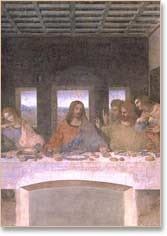Saturday, January 29, 2005

"The Last Supper was painted onto the walls of the Convent of Santa Maria delle Grazie near Milan. Leonardo spent three years painting the work, and much of that time was spent searching the streets of Milan for models of Christ and Judas. It is said that only Leonardo's threats to paint the Prior of the convent as Judas bought him the time he needed to finish.Although it was common to paint directly onto the walls of building, Leonardo was not trained in this 'fresco' technique, and made a poor choice of materials. This, along with the humid conditions in the convent, meant that the painting began deteriorating while Leonardo was still alive. The refectory has also been flooded and used as a stable - but the painting's luckiest escape came during the Second World War, when the refectory was hit by a bomb. Only some carefully placed sandbags saved this masterpiece from destruction. There have been many attempts to restore The Last Supper, most of which have done more harm than good. A full restoration was recently completed. It took twenty years - five times longer than Leonardo took to complete the original. However, virtually none of the original paint remains, and critics claim we can no longer regard this as a Leonardo painting.
The perspective focuses on the figure of Christ in the centre. The window behind his head looks like a halo. Judas is the only figure in the painting who is leaning away from Christ, and the only figure who is in shadow. In traditional paintings, Judas's halo was black.Leonardo also played tricks with the perspective in this painting. We can see the table top, even though we shouldn't be able to from where we stand. And why are so many people crowded round a table when there wouldn't be room for them all to sit?"
in
BBC
1 Comments:
There has never been an artist who was more fittingly, and without qualification, described as a genius. Like Shakespeare, Leonardo came from an insignificant background and rose to universal acclaim. Leonardo was the illegitimate son of a local lawyer in the small town of Vinci in the Tuscan region. His father acknowledged him and paid for his training, but we may wonder whether the strangely self-sufficient tone of Leonardo's mind was not perhaps affected by his early ambiguity of status. The definitive polymath, he had almost too many gifts, including superlative male beauty, a splendid singing voice, magnificent physique, mathematical excellence, scientific daring... the list is endless. This overabundance of talents caused him to treat his artistry lightly, seldom finishing a picture, and sometimes making rash technical experiments. The Last Supper, in the church of Santa Maria delle Grazie in Milan, for example, has almost vanished, so inadequate were his innovations in fresco preparation.

